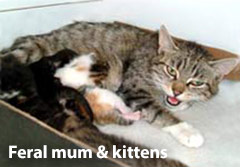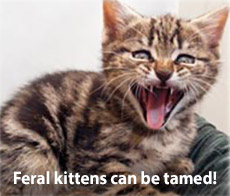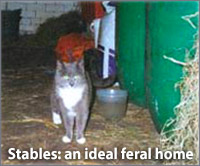What are Feral Cats? • Humane Control • Trap Neuter Return (TNR) • Getting Help! • Help Needed - Colony Management and Kitten Taming! • Outdoor Homes Needed • Further Help & Usefeul Links
What are Feral Cats?
Feral cats are once domestic cats, or the descendants of once domestic cats, and their offspring, who are now living in the wild. Originally they may have been pets, or the descendants of once domestic cats abandoned by uncaring owners, or who have simply wandered away from home and got lost, often due to not having been neutered.
These wild-living cats then often form colonies wherever there is shelter and a food supply e.g. farms, industrial estates, abandoned areas of land, rubbish tips etc. Urban ferals congregate near dustbins, markets or where animal lovers provide food. Where there is one feral puss there are sure to be others. They may perform a useful function by hunting rodents attracted to edible refuse, but to some members of the public they are seen as an annoyance forever in fights and breeding into epic proportions.
Why Humane Control is Needed
 Feral colonies can act as reservoirs of viruses such as FeLV/FIV which can be transmitted to domestic pet cats when interacting with ferals. They are more prone to be involved in road traffic accidents and it’s fair to say that a feral life is a hard life and many don’t make old bones. In an un-managed colony, feral cat numbers can increase to such a degree that they may become unhealthy through continued breeding, interbreeding, poor nutrition and fighting (especially among unneutered tom cats).
Feral colonies can act as reservoirs of viruses such as FeLV/FIV which can be transmitted to domestic pet cats when interacting with ferals. They are more prone to be involved in road traffic accidents and it’s fair to say that a feral life is a hard life and many don’t make old bones. In an un-managed colony, feral cat numbers can increase to such a degree that they may become unhealthy through continued breeding, interbreeding, poor nutrition and fighting (especially among unneutered tom cats).
Left un-checked, it is a continual breeding cycle, where female cats may have one litter partially weaned and already be pregnant with another litter. Becoming continually pregnant also takes a high toll on the female cat, and often leads to potentially fatal diseases. Kittens are often abandoned to fend for themselves or eventually die if food becomes scarce.
 It has been estimated that up to 80% of feral kittens die in their first year through accident or disease, but since kittens attract more attention and sympathy from people than do adult cats this is often when rescue organisations are contacted and, as a result, find themselves in possession of spitty, hissy kittens which need to be tamed and eventually homed.
It has been estimated that up to 80% of feral kittens die in their first year through accident or disease, but since kittens attract more attention and sympathy from people than do adult cats this is often when rescue organisations are contacted and, as a result, find themselves in possession of spitty, hissy kittens which need to be tamed and eventually homed.
If the kittens are not rescued, they will continue to expand the colony by breeding from as young as four months old, making the problem worse. Taming feral kittens for a domestic home is usually possible if they are caught at a young enough age (ideally 6 - 8 weeks) and socialised by a patient fosterer, however there will be some which will never tame however much love, effort and attention is given to them, and in those cases outdoor homes must be found.
The number of suitable outdoor homes available are limited, and rescue organisations continually struggle to find places for them, therefore controlling future feral numbers through neutering is the only sensible solution.
The feral cat over-population problem in the UK is largely man-made! By neutering and managing colonies, the future feral population can be reduced humanely.
Trap-Neuter-Return (TNR)
The humane way to control a feral colony is to trap and neuter all the mature adults and return them to the colony site. If kittens are caught young enough they can be tamed and homes found for them. Trapping and neutering a large feral colony can take weeks (or months), and then regular monitoring is needed to make sure that no cats were missed. To help identify neutered cats, many vets clip the top of their ear (called 'ear-tipping') which causes no distress to the cat.
Find out more about helping feral cats using TNR, in our 'Managing a feral cat colony' blog.
Sadly, it is often impractical to treat sick or injured ferals in the same way as a domestic cat. Feral cats are unused to human contact and get highly stressed when handled. Long term veterinary care for a feral cat who has to be regularly caught, sedated and treated is just not viable so, sadly in some cases a rescue is faced with the difficult decision to have the cat put to sleep. Again, the sooner a colony is reported, and managed, the better for the health of the cats.
Get Help before it's out of control!
 If you find yourself dealing with a feral, or semi-feral population of cats, then your first course of action is to contact your local animal welfare or rescue organisations. Not all rescues have the resources or the money to deal with ferals but most will be able to advise as to who will be able to assist. The most important thing is not to ignore the ‘growing’ problem, as each month that passes may well see an increase in the numbers of ferals and associated kittens to deal with.
If you find yourself dealing with a feral, or semi-feral population of cats, then your first course of action is to contact your local animal welfare or rescue organisations. Not all rescues have the resources or the money to deal with ferals but most will be able to advise as to who will be able to assist. The most important thing is not to ignore the ‘growing’ problem, as each month that passes may well see an increase in the numbers of ferals and associated kittens to deal with.
Feral cats pose a big problem for rescues, as they take a large amount of time and resources (both human and financial) to deal with. However, the sooner you report an un-managed feral colony, the smaller the problem! Rescues rely on co-operation from members of the public (to gain permission to go onto land, or to help with trapping) local veterinarians (ferals are often trapped at night after many vets are closed) and they need specialist trapping and handling equipment, which is often in short supply. Many rescues rely totally on volunteers, many of whom work during the day, so having time to trap and transport ferals is a big challenge. With co-operation from members of the public, and anyone able to offer voluntary help, the task is not so daunting.
Need Help with Feral Cats? Rescue Groups near you who offer Feral Cat Assistance »
Please report an un-managed Feral Colony as soon as possible...
before the number of cats gets out of hand!
Hands-on Volunteer Help Needed:
Colony Management:
Rescues who deal with feral cat colonies always need more volunteers to help manage them; for feeding duties, as well as trapping and transporting cats to the vets for neutering. Find your local Cat Rescue groups »
Kitten Tamers needed!
Most rescues are almost always in need of more volunteer fosterers willing to care for and socialise feral kittens, or kittens of stray mums who have not been used to human contact. If rescued young enough such kittens can be successfully 'socialised' and then rehomed to a normal, domestic environment. Find out about Kitten Fostering »
Rural / Outdoor Homes Needed:
 Rescues who deal with helping feral cats, are frequently in need of new locations to place them, because it isn’t always possible to return them to their original home, (for instance on a building site, where it is just too dangerous).
Rescues who deal with helping feral cats, are frequently in need of new locations to place them, because it isn’t always possible to return them to their original home, (for instance on a building site, where it is just too dangerous).
If you can offer a safe place for one or more feral, ex-feral or semi-feral cats then please contact your local rescue organisations, they would be very pleased to hear from you. Not all rescues will have feral cats needing a place to go, but most will know a rescue who does. Ideal homes are: Farms, Smallholdings, Stables, or just a rural home with some land or a large garden. Having a small colony of feral cats in such environments is mutually beneficial - they take care of ‘Mouse Control’ and you supply them with a safe home. You would need to provide them with regular food and clean water daily, and somewhere warm and dry to shelter, such as a barn or outbuilding. Feral cats relocated via a rescue group will already be neutered, but you will need to keep an eye on them to make sure that they remain healthy.
When feral cats are re-located they should be confined to a secure indoor area such as a barn, containing bedding areas, litter trays and food and water for up to 3 weeks, whilst they acclimatise to their new environment, otherwise they will simply run away when released. Although they will initially fear human contact, over time you should be able to earn their trust to some extent. Some feral cats may even become friendly to varying degrees.
The feral cat’s lifespan is generally not as long as that of a domestic cat, but with a caring attitude and with the help of a rescue organisation it can be healthy and disease free. Ferals living in a safe, managed environment have been reported as living up to, and occasionally over, 20 years.
Feral Cats offer Mouse Control services, in exchange for food and shelter.
Could you offer Feral Cats a rural or farm home?
Further Help & Useful Links:
Rescue and Welfare Groups offering help with Feral Cats (advice / rescue / relocation / neutering).
Could you offer a rural home to feral / farm cats? Feral / Farm Cats - Homes needed
Cat Rescue Centres and Rehoming Groups - Cat Rescue Centre Listings for the UK & Ireland
Feral Cat Information - Humane Society of the US: www.humanesociety.org/feralcats
TNR Case Studies - Cat Action Trust 1977: www.cat77.org.uk
Taming Feral Kittens - Cat Action Trust 1977: www.cat77.org.uk
For rescue workers: International Cat Care's free, high quality advice & information resource for those working with unowned cats (ie feral / community cats): Cat Friendly Solutions for Unowned Cats.
Photo Credits: Thanks to Yorkshire Cat Rescue, Paws Inn Cat Rescue, Mid Cheshire Animal Welfare and Coppercat Photography for supplying photos for this page.



